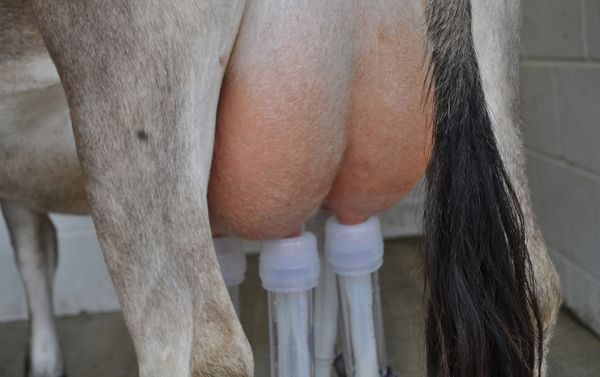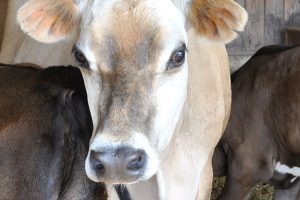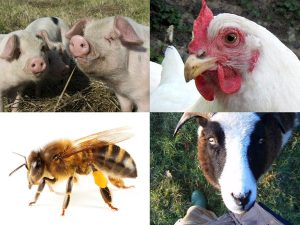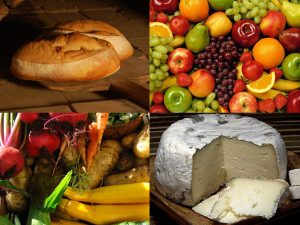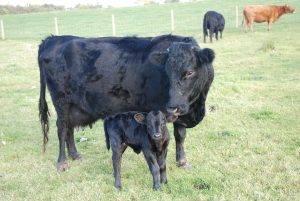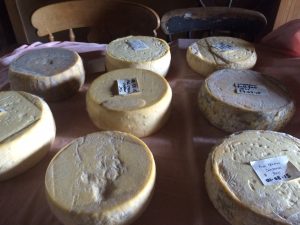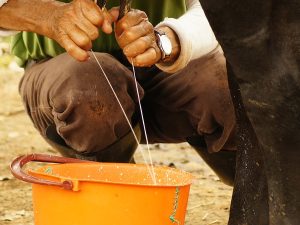Welcome to part 4 of this series on cow-calf dairying, focusing on udder development. By now you will be starting to understand that keeping calves on dairy cows is a fine art; that it is a case of balancing the emotional and physical needs of both cow and calf; and why there are no set rules, just guidelines.
In this post, we will look at udder development and how the age of weaning can impact on a heifer’s ability to be an efficient milk producer in future.
Udder development
It is well documented that heifer calves who have been suckled on their dams in the first 2 to 3 months have far greater growth rates and are taller than those fed conventional milk-replacer. They also reach puberty sooner and have a tendency for greater milk production in their first lactation.
However, there is another decision to make regarding weaning dates for heifer calves destined for the milking parlour. This is because continuing on this very high plane of nutrition past 5 months old can have a detrimental impact on udder development.
Cows’ milk production peaks at around 3 months into their lactation. This is the same for beef and dairy cows and coincides with the need to support the rapid growth of the calf before its rumen is developed sufficiently to fully take over from the nutritionally dense milk.
The calf is a monogastric animal when born, subsisting on milk, which, as explained in Part Three, predominantly by-passes the rumen and is digested and absorbed in the abomasam in a similar way to any other monogastric, like us. As the rumen develops, the calf has two digestive systems running in parallel: both monogastric for the milk and ruminant for the fibre. Gradually, as the rumen develops it takes over.
In the more ‘natural’ beef suckler system and (if you follow our Pirate’s Code on cow-calf dairying) in your dairy suckler system too, by 3 months old the rumen is starting to become the dominant digestive system.
As the dam’s production starts to decrease after 3 months and the calf’s rumen is beginning to fire on all cylinders (if not yet at full throttle), the calf is incentivised to eat even more fibre, which in turn further accelerates rumen development.
By 5 months old, the rumen should be functioning well and taking over as the primary digestive system, supporting good growth rates without the need for milk. And if you think about the natural annual cycle of the ancient herbivores that domestic cows are descended from, it makes perfect sense that the cow, being back in calf by this time, would be instinctively conserving energy for the growing foetus inside her, decreasing milk production for the calf at foot and encouraging that calf to go forage more for its food.
So it comes as no surprise then that through evolutionary selection, in a heifer, the pre-pubertal period of udder development between 5 and 9 months old is best served by a slightly decreasing nutritional plane during this time.
Heifer calves nutrition between 5 and 9 months old
In Part Two, we covered how milk is made in the alveoli, which are connected via ducts to the teat. When a heifer calf is born she does not have any ducts or alveoli, just adipose tissue in the udder area, called the ‘fat pad’.
At around 2 to 3 months old, she starts an allometric (disproportionately faster) growth phase of her udder and this is when the development of the duct network within the adipose tissue begins. No alveoli are formed until she actually becomes pregnant, but the formation of the duct network that occurs up until puberty (around 9 to 11 months) determines how many alveoli will develop during her first gestation.
Allometric growth continues until around 12 months old and during this time it is important that the heifer does not get fat. There is a critical period, between 5 and 9 months, when this is particularly important because the extent of growth and development of the duct network, ie the number of ducts formed, is at its greatest during this time.
Should the heifer be on too high a plane of nutrition during this critical period, she will start to lay down fat in her udder tissue and get what is called a ‘fatty udder’. Too much fat in the udder inhibits the development of the duct network and the fewer ducts that are formed at this time, the fewer alveoli will form during pregnancy.
There are many factors affecting milk production but fundamentally it is a function of the number of alveoli times the amount of milk each one can synthesise.
So there is a real risk with cow-calf dairying that a heifer calf grows too fast, gets big and strong and looks great, but is unproductive when it comes to milking. This is not to say we want high-yielding cows. Quite the opposite, we want low-input, low-output cows but cows nonetheless that are efficient in their production.
Cow-calf dairying at Smiling Tree: what we do and why
When and how to wean dairy calves is, therefore, critical not just to their short-term contentedness at weaning time but to their long-term productivity. Every animal’s needs are considered individually and everything we do in our system revolves around setting up for a stress-free weaning. For heifers, in order to prevent them getting too fat ,we aim to wean them at 5 months old.
In Part Five, we get down to the nitty-gritty of cow-calf dairying here at Smiling Tree Farm, with practical step-by-step guidance for training a cow to milk whilst keeping her calf at foot, and building confidence and independence in the calves for a safe and stress-free weaning.

